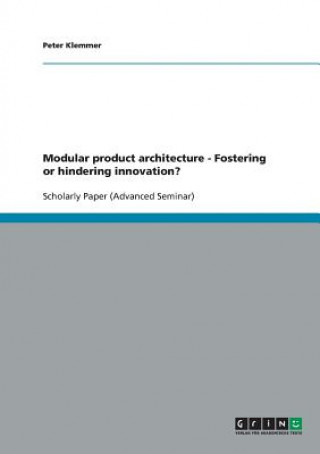
Kód: 01604841
Modular product architecture - Fostering or hindering innovation?
Autor Peter Klemmer
Seminar paper from the year 2007 in the subject Business economics - Supply, Production, Logistics, printed single-sided, grade: 2,0, LMU Munich (Innotec - Institut für Innovationsforschung, Technologiemanagement und Entrepreneurs ... celý popis
- Jazyk:
 Angličtina
Angličtina - Vazba: Brožovaná
- Počet stran: 60
Nakladatelství: Grin Publishing, 2007
- Více informací o knize

Mohlo by se vám také líbit
Dárkový poukaz: Radost zaručena
- Darujte poukaz v libovolné hodnotě a my se postaráme o zbytek.
- Poukaz se vztahuje na celou naši nabídku.
- Elektronický poukaz vytisknete z e-mailu a můžete ihned darovat.
- Platnost poukazu je 12 měsíců od data vystavení.
Více informací o knize Modular product architecture - Fostering or hindering innovation?
Nákupem získáte 108 bodů
 Anotace knihy
Anotace knihy
Seminar paper from the year 2007 in the subject Business economics - Supply, Production, Logistics, printed single-sided, grade: 2,0, LMU Munich (Innotec - Institut für Innovationsforschung, Technologiemanagement und Entrepreneurship), course: Innovationsmanagement: "Theorie Empirie Case Studies , 34 entries in the bibliography, language: English, abstract: Industrialization processes in the last decades have resulted in the emergence of immense new industries, which for a great part can be ascribed to comprehensive activities of technological innovation. Driven by dynamic market contexts such as globalization or technological advances leading to growing complexities and evolving consumer demands, firms are however increasingly affronted with the challenge to offer a greater variety of products of improved performance in less time and under lower costs (Momme et al. 2000, p.128; Ulrich/Eppinger 1995, p.5). Technological innovation as the means and ends of new product development therefore plays a significant role.Modular product architecture -with products that made up of a set of independent components, connected only via defined interfaces (Ulrich/Eppinger 1995, p.132)- is predominantly found in technologically intensive industries such as telecommunications, electronics or the automobile sector (Sanchez/Mahoney 1996, p.67; Staudenmayer et al 2005, p.308). Under the light of the challenges affronting firms, this paper examines the effects, modular product architecture has on technological innovation. This paper investigates the effects of modular product architecture with standardized open interfaces assuming many component producers and a central firm controlling the systemic fit of these.From a resource and production point of view, modularity in combination with a coherent process infrastructure enables firms to meet market demands described (Sanchez 2004, p.59). In addition, product-strategic flexibility is significantly improved involving the possibilities of mass-customization through flexible up- & downscaling. The setting described leads to an outsourcing of innovation activity to component producers, pursuing autonomous trial & error innovation and to consumers, independently performing mix & match innovation. Furthermore, this may induce changes on the architectural level of products (Baldwin/Clark 1997, p.85; Cusumano/Gawer 2002, p.55). The paper further suggests that technological innovation with modularity applied, leads to a steady evolution of products (Galvin/Morkel 2001, p.34; Langlois/Robertson 1992, p.310). The resulting changes can show sustaining (Christensen 1997, p. xv) character, but equally may disrupt existing knowledge in the event of integrative innovation. The X-Box case powerfully demonstrates key aspects of product modularity and its effects on technological innovation.
 Parametry knihy
Parametry knihy
Zařazení knihy Knihy v angličtině Economics, finance, business & management Business & management
1084 Kč
- Plný název: Modular product architecture - Fostering or hindering innovation?
- Autor: Peter Klemmer
- Jazyk:
 Angličtina
Angličtina - Vazba: Brožovaná
- Počet stran: 60
- EAN: 9783638861557
- ISBN: 3638861554
- ID: 01604841
- Nakladatelství: Grin Publishing
- Hmotnost: 91 g
- Rozměry: 210 × 148 × 4 mm
- Datum vydání: 21. November 2007
Oblíbené z jiného soudku
-

Official Guide to the TOEFL iBT Test, Sixth Edition
811 Kč -

Die 36 Strategeme der Krise - Erfolg haben, wenn andere scheitern
501 Kč -

Toyota Way, Second Edition: 14 Management Principles from the World's Greatest Manufacturer
704 Kč -

The Advantage
568 Kč -

The Big Book of Dashboards
962 Kč -

Sales Enablement
520 Kč -

Rich Woman
397 Kč -

Your Successful Farm Business
589 Kč -

Eat That Frog!
364 Kč -

Personal MBA
357 Kč -

Good To Great
624 Kč -

Transformed: Moving to the Product Operating Model
629 Kč -

The Hard Thing about Hard Things
638 Kč -

Motive - Why So Many Leaders Abdicate Their Most Important Responsibilities
485 Kč -

Slight Edge
418 Kč -

The Personal MBA 10th Anniversary Edition
441 Kč -

Crucial Conversations: Tools for Talking When Stakes are High, Third Edition
662 Kč -

Marketing 5.0 - Technology for Humanity
572 Kč -

Thinking In Bets
418 Kč -

The Millionaire Real Estate Investor
513 Kč -

Management
721 Kč -

The Fearless Organization
611 Kč -

Millionaire Real Estate Agent
543 Kč -

Karmic Management
366 Kč -

Playing with FIRE (Financial Independence Retire Early)
382 Kč -

4 Stages of Psychological Safety
463 Kč -

Ultimate Guide to Dropshipping
298 Kč -

True Professionalism
357 Kč -

Leading with AI and Analytics: Build Your Data Science IQ to Drive Business Value
624 Kč -

Competition Demystified
424 Kč -

The Goal
708 Kč -

The Power of Full Engagement
453 Kč -

Ready, Fire, Aim - Zero to GBP100 Million in No Time Flat
793 Kč -

Ride of a Lifetime
462 Kč -

Thinkertoys
462 Kč -

You Can Negotiate Anything
350 Kč -

Free to Choose
355 Kč -

Trusted Advisor
464 Kč -

Quality of Earnings
374 Kč -

LOVED: How to Rethink Marketing for Tech Products
676 Kč -

Truth About Employee Engagement - A Fable About Adressing the Three Root Causes of Job Misery
520 Kč -

The Machine That Changed the World
371 Kč -

Cryptoassets: The Innovative Investor's Guide to Bitcoin and Beyond
872 Kč -

Confessions of a Recovering Engineer - Transportation for a Strong Town
502 Kč -

Art of Closing the Sale
471 Kč -

What the CEO Wants You to Know
306 Kč -

Smart Couples Finish Rich
404 Kč -

What's Your Problem?
773 Kč -

Design Thinking for Business Growth: How to Design and Scale Business Models and Business Ecosystems
665 Kč
Osobní odběr Praha, Brno a 12903 dalších
Copyright ©2008-24 nejlevnejsi-knihy.cz Všechna práva vyhrazenaSoukromíCookies










 Vrácení do měsíce
Vrácení do měsíce 571 999 099 (8-15.30h)
571 999 099 (8-15.30h)